Template:Semi-protected
- "He wore a tall pointed grey hat, a long grey cloak, and a silver scarf. He had a long white beard and bushy eyebrows that stuck out beyond the brim of his hat."
- —The Fellowship of the Ring, "A Long-expected Party"
Gandalf (Norse; IPA: [gand:alf] - "Elf of the Wand" or "Wand-elf") the Grey, later known as Gandalf the White, and originally named Olórin (Quenya; IPA: [oˈloːrin] - "Dreamer" or "Of Dreams"), was an Istar (wizard), sent by the West in the Third Age to combat the threat of Sauron. He joined Thorin and his company to reclaim the Lonely Mountain from Smaug, convoked the Fellowship of the Ring to destroy the One Ring, and led the Free Peoples in the final campaign of the War of the Ring.
Biography
Years of the Lamps

Gandalf as a Maia (named Olórin) before leaving the Undying Lands
Originally called Olórin, he was accounted as the wisest of the Maiar (with the possible exception of Melian). He was a Maia of Manwë and Varda. He also served under two other Valar, such as Irmo and Nienna. When the Valar decided to send the order of the Istari (also known as Wizards) to Middle-earth, to counsel and assist all those in Middle-earth who opposed the Dark Lord Sauron, Manwë and Varda decided to include Olórin among the five who were sent.
At first, Olórin was nervous and described himself as too weak and too afraid of Sauron. Manwë understood, and told him that that was one main reason why he should go, to overcome that fear. Thus, he insisted that Olórin should go as the third, but Varda convinced him not to include Olórin as the third, but as the second.[1] Olórin agreed, and prepared for his departure from the Undying Lands with the other four wizards.
Third Age
Arrival in Middle-earth
When he arrived to Middle-earth, he received Narya, the ring of fire, from Círdan the Shipwright.[2] Olórin, renamed Gandalf, spent many centuries walking among the Elves as a stranger, learning from them and teaching them. He later revealed himself as one of the Istari, and eventually became known as the wisest of and most powerful of that order. He joined the White Council, which was formed to investigate a dark power in Dol Guldur, of which Galadriel wanted him to become the leader, yet Saruman came to lead the Council instead of him.[3] Although Saruman was initially more powerful, was more knowledgeable about many matters regarding Sauron and the Rings of Power, and was head of the White Council before the War of the Ring, he later grew jealous and afraid of Gandalf,[2] which was the reason of his betrayal.
Quest to Erebor
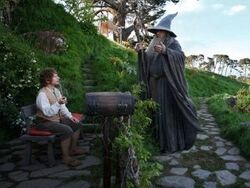
Gandalf invites Bilbo on an adventure
Gandalf wandered for many years amongst the Free People of Middle-earth, but spent most of that time amongst the Elves, where he learned much and taught much. He also continued to gather such information about Sauron and his ilk as he could, and to that end, he began to suspect that the Necromancer of Dol Guldur was in fact Sauron taking shape once again. He entered Dol Guldur, but Sauron, still greatly weakened, fled from him and for a short time, the evil of Mirkwood was greatly reduced. However, Sauron quickly returned to Dol Guldur, and by 2850 of the Third Age, had rebuilt his forces there. In that year, Gandalf again entered the fortress and encountered Thráin II, father of Thorin Oakenshield, who was dying after having been horribly tormented. Before his death, the old Dwarf king entrusted Gandalf with a map and key to the Lonely Mountain.
In the year 2941, Gandalf became troubled by his knowledge of Sauron's resurgent strength. He knew that Sauron was already plotting war from Dol Guldur, and that as soon as he felt strong enough, he would attack Rivendell. Unfortunately, the only power left besides Rivendell to resist an attempt from Mirkwood to regain the lands of Angmar was the Dwarves of the Iron Hills. Even worse, Gandalf knew that Smaug to Golden resided still in the Lonely Mountain, and that Sauron could and would use the dragon to devastating effect once he became strong enough to influence Smaug. However, Saruman seemed reluctant to engage Sauron's forces, though none of the White Council realized that he was already a traitor.
One night, while pondering the problem of the Free People's weakness in the North, Gandalf had a chance encounter in Bree with the Dwarf Thorin II Oakenshield, who was also searching, without direction or much hope, for a way to reclaim the Kingdom Under the Mountain. Gandalf and Thorin then concocted a plan (more Gandalf's than Thorin's) to potentially draw the dragon out of the mountain and reclaim the kingdom. To that end, Gandalf visited Bilbo Baggins, a Hobbit of the Shire, to convince him to go with Thorin and Company to Erebor and aid them.[4] At the time, Bilbo thought of him as little more than a vain, a fussy old conjurer who entertained children with fireworks during festivals and parties, but soon discovered his true nature.[5] It is on this quest that Gandalf finds his sword, Glamdring, and that Bilbo finds his sword, Sting,[6] and the One Ring (though at the time it is mistaken for a lesser ring).[7]
Gandalf himself joined the quest both in order to see what he could do to destroy the dragon, and to try to convince the White Council (particularly Saruman) to oust Sauron from Dol Guldur. During the Dwarves' quest, Gandalf vanished twice— once to scout their path,[6] the second time to "attend to other pressing business",[8] the nature of which he refused to discuss. He was actually attending a meeting of the White Council. When Bilbo found the One Ring, Gandalf was immediately suspicious of the Hobbit's story of how he acquired it. He privately confronted Bilbo and forced the truth out of him, and is deeply troubled by his story of the Ring's powers as they seem eerily familiar. Perhaps even more troubling to him is that Bilbo, a proper, honorable hobbit, would uncharacteristically lie about his story.
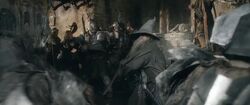
Gandalf fighting at Battle of the Five Armies
Gandalf abandoned Thorin's company when they reached Mirkwood to participate in the White Council's assault on Dol Guldur. The attack appeared to drive out The Necromancer (Sauron), though he immediately retreated to his long-prepared stronghold of Barad-dûr. Gandalf rejoined Thorin's company at the very moment the Battle of Five Armies breaks out, bearing news of the arrival of a goblin and warg army. Gandalf fought in the battle, and helped destroy the goblin threat. Thorin himself was slain during the battle, but Gandalf's primary aim was achieved; with the destruction of Smaug and the ousting of the goblin army, Dáin II Ironfoot became King under the Mountain and restored the Lonely Mountain to a powerful kingdom. This, along with the strengthening of the Kingdom of Dale, allowed the Free People of the Northern region of Middle-earth to have considerable preparation against Sauron's forces during the later War of the Ring, where before they had virtually none. Following the battle, Gandalf accompanied Bilbo back to the Shire.[9]
Before the War
Return to the Shire
Gandalf spent the years between TA 2941 to TA 3001 travelling Middle-earth in search of information on Sauron's resurgence and Bilbo's mysterious ring. He spent as much time as he could in the Shire, however, strengthening his friendship with Bilbo and befriending Bilbo's nephew, Frodo, while simultaneously becoming suspicious of Saruman and his allegiances.
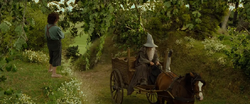
Returning to the Shire
In TA 3001, around the time of Bilbo's "Eleventy-First" (111th) birthday party, Gandalf returned to the Shire, bringing along many fireworks for the occasion. After seeing Frodo and visiting Bilbo again, Gandalf attended the party.[10]
During Bilbo's speech, he put on a mysterious ring and disappeared, as a joke on his neighbours. Later as he was bidding farewell to Gandalf, who had known about his plans to leave, Bilbo began to change his mind about leaving his ring to Frodo, as he had earlier agreed. When Gandalf tried to persuade him to leave it, Bilbo became hostile and accused Gandalf of trying to steal the ring for his own benefit, which he referred to as his "precious." Horrified by Bilbo's outburst, Gandalf stood to his full height and appeared menacing, frightening the hobbit. This brought Bilbo back to his senses; he apologised, admitted that the Ring had been troubling him lately, and left the ring behind. Bilbo and Gandalf bid each other goodbye, before Bilbo left the Shire for his journey.[11]
Gandalf mulling over Bilbo's erratic behaviour
Troubled by this, Gandalf mulled over this. Before finally leaving the Shire, Gandalf gave the ring to Frodo, advising him to keep it safe. Over the next seventeen years, Gandalf traveled extensively, searching for answers. Having long sought for Gollum near Mordor, he met Aragorn, who had captured the creature in Mirkwood.[12]
Gandalf interrogated Gollum and learned that Sauron had forced Gollum to tell what he knew about the ring under torture. Gandalf left Mirkwood soon after, and left Gollum with the Wood-elves of Northern Mirkwood.
Saruman's betrayal
Gandalf telling Frodo about the Ring
Upon returning to the Shire, Gandalf immediately went to Frodo and confirmed his suspicions by throwing the Ring into Frodo's hearth fire, which revealed, in Black Speech, the inscription upon the ring. Gandalf then told a dumbfounded Frodo about the One Ring and its history, and how Sauron would seek to regain it. Instructing Frodo to go to Rivendell with the ring, Gandalf told him to make arrangements to leave the Shire quietly.
Riding near the Shire, Gandalf encountered Radagast the Brown, another Wizard, referred to as "his cousin", who asked him to seek out Saruman the White, as the Nazgûl had come forth and crossed the River Anduin. Before he left, Gandalf instructed Radagast to alert all the 'birds and beasts' that were friendly to the latter to convey messages about the Nazgûl to Saruman and Gandalf at Orthanc.
Gandalf imprisoned at Isengard
Leaving a note for Frodo with Barliman Butterbur, an inn-keeper in Bree, Gandalf left for Isengard to speak with Saruman. Once there, however, Gandalf discovered that Saruman wanted the One Ring to himself and declared himself Saruman of Many Colours. He tried to convince Gandalf to either join with him in service to Sauron, so that they could eventually control the Dark Lord and thus achieve good ends, though through evil means, or to help him find the One Ring so they could take power from Sauron. Gandalf refused, and was held prisoner at the top of the tower Orthanc.
Journey to Rivendell
Gandalf being rescued
After spending a while as Saruman's prisoner, Gandalf was eventually rescued by Gwaihir the Eagle. Gwaihir's real purpose for visiting Orthanc was to report a sighting of the Nazgûl, as Radagast had appealed to him to do so earlier on. The great Eagle set Gandalf down in Rohan, where he appealed to King Théoden for a horse.
King Théoden allowed Gandalf to take any horse he desired, but only to do so quickly. There, Gandalf chose the horse Shadowfax. Riding for the Shire, Gandalf arrived too late for Frodo; he had already set out.
Knowing that Frodo would be heading for Rivendell, Gandalf began to make his own way there. Shortly after arriving in Bree, Gandalf learned that the Hobbits had already began travelling to Rivendell with his ally and old friend: Aragorn.[13] Subsequently, Gandalf was confronted one night by Sauron's Nazgûl at Weathertop. After an all-night battle with the Ringwraiths, Gandalf was able to eventually escape, though four of the nine Nazgûl pursued him.
Several days later, Frodo, Aragorn, and company stayed at Weathertop and were confronted by the remaining five Nazgûl. Despite their escape, Frodo was stabbed in the process by the Ringwraith leader, who used a Morgul-blade.[14] Gandalf was able to evade the four Nazgûl and successfully reach Rivendell. However, several days later, an injured Frodo arrived at the Ford of Bruinen, though the Nazgûl pursued him all the way there. Gandalf, along with Elrond, saved Frodo from the Nazgûl by enchanting the water and sweeping them away.[15]
Forming of the Fellowship
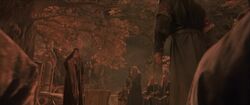
Gandalf reciting the Ring-verse in the Black Speech of Mordor at the Council of Elrond
At Rivendell, Gandalf, along with Frodo, Bilbo, and many others, attended the secret Council of Elrond. There Gandalf explained to the others how Saruman had imprisoned him and how the White Wizard was creating his own army of orcs to rival Sauron's.[16]
As everyone at the Council debated over the ring, Frodo offered to be the ring-bearer and take it to Mount Doom to be destroyed. Gandalf volunteered to help and protect Frodo on his quest, along with Aragorn, Boromir, Legolas, and Gimli. Sam snuck in and was allowed to go because of this.[16]

Gandalf leading the Fellowship through Caradhras
With this the Fellowship of the Ring was formed. Gandalf later convinced Elrond to allow Frodo's cousins, Merry and Pippin, to join the Fellowship. Subsequently, after preparing for the journey, the Fellowship left Rivendell. Gandalf took leadership of the Fellowship, leading the group south after leaving Rivendell. He and Aragorn led the hobbits and their companions on an unsuccessful effort to cross Mount Caradhras.
War of the Ring
Mines of Moria
They then took the "dark and secret way" through the Mines of Moria, much to Aragorn's discomfort; though he had passed through the Mines once before, he had no desire to go through them again, and he feared for Gandalf if they did so. As they tried to leave the mines, at the Bridge of Khazad-dûm, Gandalf faced a Balrog, known commonly as Durin's Bane.[17] It was one of the Maiar corrupted by Melkor in the early days of Arda.
You cannot pass," he said. The orcs stood still, and a dead silence fell. "I am a servant of the Secret Fire, wielder of the flame of Anor. You cannot pass. The dark fire will not avail you, flame of Udûn. Go back to the Shadow! You cannot pass.
—The Lord of the Rings, The Fellowship of the Ring, Book II, Chapter 5: "The Bridge of Khazad-dûm"

Gandalf confronts Balrog
Gandalf stopped on the Bridge, standing in the middle of the span, allowing the others to escape. He leaned on the staff in his left hand and held the sword Glamdring, gleaming cold and white, in his right. The Balrog stepped onto the Bridge, facing Gandalf, and the shadow about it reached out like two vast wings. It raised its whip, and the thongs whined and cracked. Fire came from its nostrils. But Gandalf stood firm and declared that the Balrog could not pass. They clashed, and the Balrog's sword was shattered. Then the Balrog leaped full upon the Bridge, and Gandalf lifted his staff and smote the span. His staff broke, but the Bridge cracked at the Balrog's feet. The stone beneath the Balrog broke and fell, taking the Balrog with it into the abyss, but the thongs of its whip snared Gandalf about his knees, and Wizard and Balrog plummeted together into the darkness below. Galdalf cried, "Fly, you fools!" and was gone.[17]

"Fly, you fools!"
Gandalf and the Balrog fell for a long time, and Gandalf was burned by the Balrog's fire. Then they plunged into a deep lake in the depths of the mountain, which Gandalf later said was cold as the tide of death and almost froze his heart. They fought in the water until finally the Balrog fled into dark tunnels, where the world is gnawed by nameless things, older even than Sauron. Gandalf pursued the creature until it led him to the spiraling Endless Stair, and they climbed it until they reached Durin's Tower in the living rock of Zirakzigil, the pinnacle of the Silvertine above the clouds. There they fought, until at last Gandalf threw down his enemy, and the Balrog broke the mountain-side as it fell. Then darkness took Gandalf, and he passed away. His body lay on the peak. The entire battle, from the confrontation on the Bridge of Khazad-dûm to the mutual demise of the Balrog and Gandalf, had taken ten days.
Then darkness took me, and I strayed out of thought and time, and I wandered far on roads that I will not tell.
—Gandalf the White.
Twenty days later Gandalf returned to life, and lay in a trance.
Naked I was sent back – for a brief time, until my task is done. And naked I lay upon the mountain-top. … There I lay staring upward, while the stars wheeled over, and each day was as long as a life-age of the earth.
—The Lord of the Rings, The Two Towers, Book Three, Chapter V: "The White Rider"

Gandalf the White returns reborn
Three days later he was found by the windlord Gwaihir, the Lord of the Eagles, who had been sent by Galadriel to find him. Gandalf was carried to Caras Galadhon in Lothlórien, where he was healed, and clothed in white, and thus became Gandalf the White.
In Fangorn forest he encountered Aragorn, Gimli, and Legolas while they were tracking Pippin and Merry, who had been captured by orcs in Gandalf's absence.
Rohan
Keep well the Lord of the Mark, till I return. Await me at Helm's Gate. Farewell!
—Gandalf to Aragorn and Éomer and the men of the king's household.
Revealing himself to the three, he explained how he had survived and returned. There, Gandalf tried to persuade Aragorn to go to Rohan instead, insisting there are other pressing matters, such as the War coming to Rohan and the impending attack on Edoras by Saruman.[18]
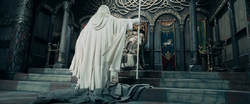
Gandalf confronting Théoden, controlled by Saruman
Arriving in Rohan with Aragorn, Gimli, and Legolas, Gandalf discovered King Théoden, weakened by Saruman's agent, Grima Wormtongue. However, Gandalf quickly broke Wormtongue and Saruman's hold over Théoden.[19]
While Théoden and the Rohirrim rode to Helm's Deep to do battle with the hordes of Isengard, Gandalf rode to Orthanc and asked Treebeard to encourage the Huorns to Assist him in defeating Saruman and his Uruk-hai. He also rode to find Erkenbrand and his men and persuaded them to ride to Helm's Deep.[20]
Siege of Gondor
After overthrowing Saruman, Gandalf broke his rival's staff and banished him from the Order of Wizards. Then, against his counsel, Pippin glanced into the Palantír of Orthanc that he recovered from Saruman and made contact with Sauron. He then took Pippin with him to Gondor to aid in the defense of the city. Along the way, Gandalf gave Pippin a brief history of Palantír, mentioning Feanor, and how it was fortunate that Pippin made contact with Sauron instead of himself, since he was not yet ready for a meeting with Sauron. Arriving at Minas Tirith, he met with Denethor II and tried to give him counsel.
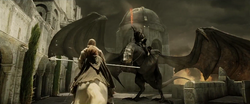
Gandalf faces the Witch-King
After Faramir's charge, the Morgul host assaulted the city. Gandalf provided valuable aid to the White City and bought precious time allowing the Rohirrim to save Gondor during The Battle of the Pelennor Fields. When the battering ram Grond breached the gates of the city, numerous trolls rushed through, attacking the defenders. However, Gandalf rode in and helped kill a few. Gandalf alone stood in defiance of the Witch-King, however Gandalf's power was never tested. With the timely arrival of Rohan, the Witch-king left to deal with the new threat. With the arrival of Rohan, and the pleas of Pippin concerning Denethor's intention to kill Faramir and himself, Gandalf rushed to Faramir's aid. Gandalf took Faramir from the pyre and tried to deter Denethor from suicide. However, driven mad by his grief and Sauron's messages via the Palantír of Minas Tirith, Denethor set the pyre aflame while looking into said Palantír. In grief, Gandalf closed the doors of the chamber. Denethor later gave out a cry and said no more. Soon afterward, Gandalf delegated the control of the city to the Prince of Dol Amroth.[21]
The Fall of Sauron
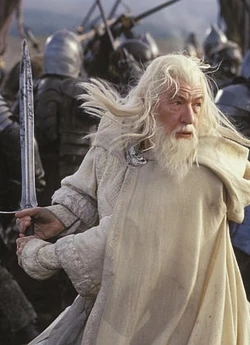
Gandalf during the final battle at the Black Gate of Mordor
Gandalf, alongside Aragorn, led the final battle against Sauron's forces at the Black Gate, waging an all-out battle to distract the Dark Lord's attention away from Frodo and Sam, who were at the very same moment scaling Mount Doom to destroy the Ring.[22] Though the forces of good were heavily outnumbered, they were able to hold back the enemy until the hobbits reached the peak of Mount Doom.
On the precipice within, looking over the fires of Mount Doom, Frodo finally succumbed the power of the Ring, slipping it onto his finger. However, Gollum, unable to bear the thought that the Ring would be destroyed, lunged at Frodo, biting off his ring finger, and the Ring, in the process. Gollum and the Ring fell into the fire, and the Ring was finally destroyed. Without Gandalf's efforts, Sauron might have learned where the two hobbits were and killed them before they could have completed their task.
Fourth Age
Four years after the ring was destroyed, Gandalf spent some time with the "moss gatherer" Tom Bombadil, then, after having spent over 2,000 years in Middle-earth, departed with Frodo, Galadriel, Celeborn, Bilbo, Elrond, (and presumably Shadowfax) across the sea to the Undying Lands, and was never seen again in Middle-earth.[23]
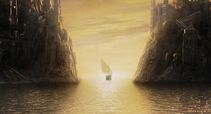
Into the West
Etymology
The name Gandalf means "Elf of the wand" or "Wand-elf", from old northern Mannish.
Within the Tolkien Legendarium, "Gandalf" translates an unknown name of the meaning "Wand-Elf" (alternatively cane/staff) in old northern Mannish. Most denizens of Middle-earth incorrectly assumed Gandalf was a Man (human), although he was really a Maia spirit (approximately equivalent to an angel). However, a less common misconception that occurred during the beginning of his career in Middle-earth was that for someone to be immortal and use as much magic as he did, he must have been an elf, although it soon became apparent to all that he couldn't be an elf, as he was old and elves don't generally age. Even because of this, the nickname stuck with him. He later gave it as his name to others he met who didn't know its original meaning.
Other names
- Olórin, his name in Valinor and in very ancient times. It comes from the Quenya olor or olos ("dream").[24] The name could also be spelled as Olorion.[25]
- Mithrandir, his Sindarin name, used in Gondor and by the Elves. It means "Grey Pilgrim", from the Sindarin mith ("grey") and ran ("wander") or rhandir ("pilgrim").[24][26]
- Tharkûn, given by the Dwarves), which means "Staff man".[25]
- Incánus, a name of unclear language and meaning. He must have acquired the name from one of his many travels in the south, near Harad.[25] Tolkien several times changed his mind about it, varying between the Latin word incanus (meaning Grey and a possible Westron invention meaning "Greymantle"), a word Ind-cano (meaning Cruel Ruler), or even a form of Southron meaning "Spy of the North".
- Old Greybeard, by the Mouth of Sauron when they meet at the Morannon.
- The White Rider (when mounted on the great horse Shadowfax)
- Stormcrow (a reference to his arrival being associated with times of trouble), often used by his detractors to mean he is a troublesome meddler in the affairs of others.
- Lathspell, by Grima Wormtongue[19]
- Gandalf Greyhame
- Gandalf the Fool
- Big Greybeard
- Pointy Hat
- Tall Fellow
- Long Greybeard
- The Grey Pilgrim
- Gandalf the Grey, and later Gandalf the White after he was reborn as the successor to Saruman.
- Gandalf the Wandering Wizard
Character Development
Many that live deserve death. And some that die deserve life. Can you give it to them? Then do not be too eager to deal out death in judgment. For even the very wise cannot see all ends.
—The Lord of the Rings, The Fellowship of the Ring, Book I, Chapter 2: "The Shadow of the Past"
Mythical roots
The Old Norse name "Gandalfr" appears in the list of dwarves in the Völuspá of the Elder Edda; the name means "cane-elf," or "wand-elf." Tolkien took the name along with the dwarves names when he wrote The Hobbit in the 1930s. He came to regret the creation of this "rabble of eddaic-named dwarves, [...] invented in an idle hour" (The Return of the Shadow:452), since it forced him to come up with an explanation of why Old Norse names should be used in Third Age of Middle-earth. He solved the dilemma in 1942 by the explanation that Old Norse was a translation of the language of Dale. The figure of Gandalf has other influences from Germanic mythology, particularly Odin in his incarnation as "the Wanderer", an old man with one eye, a long white beard, a wide brimmed hat, and a staff. Tolkien states that he thinks of Gandalf as an "Odinic wanderer" in a letter of 1946.[27] Gandalf is also similar to Väinämöinen, a Bard in Finnish mythology.
Der Berggeist
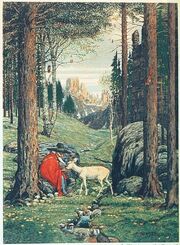
Der Berggeist
Tolkien had a postcard labelled Der Berggeist ("the mountain spirit"), and on the paper cover in which he kept it, he wrote "origin of Gandalf" at some point. The postcard reproduces a painting of a bearded figure, sitting on a rock under a pine tree in a mountainous setting. He wears a wide-brimmed round hat, and a long cloak and a white fawn is nuzzling his upturned hands.
Humphrey Carpenter in his 1977 biography said that Tolkien had bought the postcard during his 1911 holiday in Switzerland. However, Manfred Zimmerman (1983) discovered that the painting was by German artist Josef Madlener and dates to the late 1920s. Humphrey Carpenter concluded that Tolkien was probably mistaken about the origin of the postcard himself. Tolkien must have acquired the card at some time in the early 1930s, at a time when The Hobbit had already begun to take shape.[28]
The original painting was auctioned at Sotheby's in London on July 12, 2005 for 84,000. The previous owner had been given the painting by Madlener in the 1940s and recalled that he had stated the mountains in the background of the painting were the Dolomites.
Appearance
Gandalf is described as an old man with a pointed grey hat, a long grey cloak, and a silver scarf. He had a long white beard and bushy eyebrows that stuck out beyond the brim of the hat.
After he is resurrected, the change of his signature colour from grey to white is significant, for he was sent back to replace the corrupted head of the Order of Wizards and leader of the White Council Saruman as the Chief of the Order of Wizards. In the book, he says that he has himself become what Saruman should have been.
Círdan the Shipwright seemed to have foreseen this, for he entrusted the care of Narya, the Ring of Fire (one of the Three Rings of the Elves) to Gandalf rather than Saruman.
Powers and abilities
Gandalf the Grey displays the widest range of powers, though all other forms have at least this many. Though strangely, as this is more befitting a Maiar of Aule, his powers are very much linked to fire. Here is a list of a few of the times he used fire
• Heating up fire till it is blue.
• Manipulating sparks to miss all fourteen dwarves and Bilbo
• Creating massive pillars of smoke.
• And lighting a log on fire while soaking wet
Gandalf also created bright white light during the Fellowship's expedition into Moria. He later displays the ability to focus this light into a beam.
Gandalf also displays the ability to use the words of command, a system of magic system that seems far more in line with traditional magic then most other of his displays, albeit using words instead of phrases. However, he only displayed this power once, when he used it to telekinetically shut a door. Gandalf also can create force fields, which he used to tank a blow from the Balrog. This is made even more impressive given that the Balrog could harm Ungoliant, a creature who devoured the light of the thousands of star level fruits on Laurelin.
Finally, another extension of telekinesis, Gandalf could create massive shock waves of over a hundred feet.
Gandalf the White displays these same powers but more advanced. He can now move so fast that he can knock a throwing axe out of the air, and at the same time light an arrow in fire from point blank range.
He also displayed the ability to communicate with animals, specifically Shadowfax.
In The Two Towers he twice used telepathy. The more violent example being pulling Saruman towards him, and the less violent one being freeing Théoden of Saruman’s mind control.
Finally, he also shattered Saruman’s staff with telekinesis, and stripped him of his divine power.
As his unrestricted form, Olorin, he had all his pervious powers massively boosted and the ability to shapeshift. As for his raw power, he should be comparable to Arien, who could move the sun through the sky, thus making him enormously beyond most fantasy characters of this style.
However, even this form seems to have restrictions, as the Ainur were said to have their power restricted upon descending to earth. If so his true form would be enormously beyond his other forms, possibly capable of destroying entire universes.
Weapons
Gandalf primarily used his staff, but also carried a sword in combat. Sometimes during combat, Gandalf would be seen wielding both weapons against his enemies.
Staff
- Main article: Wizard Staff
Gandalf utilised his staff for various spells and abilities. He didn't use it just as a weapon; he also utilised a staff as if it were a walking stick. He initially had an old wooden staff which he lost in the Mines of Moria while fighting the Balrog. He used a new one upon becoming Gandalf the White. In the extended film adaptation, the Witch-king of Angmar seemed to know the 'activation word' for the staff - shattering it and leaving Gandalf exposed for a moment - during the Battle of the Pelennor Fields, in Minas Tirith.
Glamdring
- Main article: Glamdring
This was an Elven sword Gandalf found in a troll cave. From that point until the resolution of the War of the Ring, he used this as a weapon to complement his staff, wielding them with equal skill. In many cases, he fought with both weapons at once.
| File:Gandalf and glamdring.jpg |
Appearances in the Books and Films
In the books
- The Hobbit
- The Lord of the Rings
- The Fellowship of the Ring
- The Silmarillion
- Unfinished Tales
- The History of Middle-earth
In the films
- The Hobbit: An Unexpected Journey
- The Hobbit: The Desolation of Smaug
- The Hobbit: The Battle of the Five Armies
- The Fellowship of the Ring
- The Two Towers
- The Return of the King
Portrayal in adaptations
Hobbit and Lord of the Rings film trilogies
Sir Ian McKellen portrayed Gandalf in the The Lord of the Rings film trilogy directed by Peter Jackson.
I gave you the chance of aiding me willingly, but you have elected the way of pain!
—Saruman to Gandalf.
Sean Connery was originally considered for the role of Gandalf, but turned it down because he didn't want to spend so long in New Zealand, where the film was shot; Tom Baker of Doctor Who fame, Patrick Stewart, Christopher Plummer, and David Bowie were also considered or approached[29]. McKellen's interpretation of the role was widely praised. He was nominated for an Academy Award for his portrayal of Gandalf in The Lord of the Rings: The Fellowship of the Ring, making him the only individual cast member to be nominated for his performance. Christopher Lee, a lifelong fan of the books, had hoped to be cast as Gandalf, but due to his advancing age, he instead opted for the role of Saruman, as Gandalf required more horse riding and more sword work.
Ian McKellen reprised his role of Gandalf the Grey for the three-part adaptation of The Hobbit, noting in early interviews that he preferred portraying Gandalf the Grey to Gandalf the White, as Gandalf the Grey required a more nuanced performance. He maintains, however, that he enjoyed playing both Gandalf's, but felt Gandalf the Grey was easier and calmer to portray.
Voice Dubbing actors
| Foreign Language | Voice dubbing artist |
|---|---|
| Spanish (Latin America) | José Lavat |
| Spanish (Spain) | Pepe Mediavilla |
| Japanese | Hiroshi Arikawa |
| Czech (Czech Republic) | Petr Pelzer |
| Portuguese (Brazil) (Television/DVD) | Hélio Vaccari / Luiz Carlos Persy (The Hobbit trilogy) |
| German | Joachim Höppner † / Eckart Dux (The Hobbit trilogy) |
| Italian (Italy) | Gianni Musy † / Gigi Proietti (The Hobbit trilogy) |
| Hungarian | Ferenc Bács |
| French (France) | Jean Piat |
| Polish | Wiktor Zborowski (The Hobbit trilogy) |
| Slovak | Leopold Haverl (The Lord of the Rings)
Marián Slovák (The Hobbit trilogy) |
| Turkish | İstemi Betil |
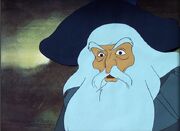
Gandalf the Grey (1978)
Rankin/Bass films
John Huston provided the voice of Gandalf in two animated television features by Rankin/Bass (The Hobbit and The Return of the King).
Ralph Bakshi's The Lord of the Rings
In the 1978 animated film of The Lord of the Rings by Ralph Bakshi, Gandalf was voiced by William Squire. (It is not known whether Squire played him in the live-action recordings used for rotoscoping.)
Radio
In the BBC radio dramatisations, Heron Carvic played him in The Hobbit (1968), Norman Shelley played him in The Lord of the Rings (1956 radio series), and Sir Michael Hordern played him in The Lord of the Rings (1981).
Video games
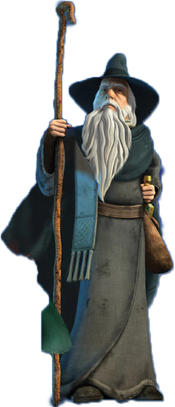 Gandalf in The Hobbit game.
Gandalf is a character that appears in the The Hobbit (2003 video game). He is a tall wizard who is just called "Gandalf." He organizes The Quest of Erebor with Thorin. He is not a playable character, but gives Bilbo different jobs and helps him against the powerful and unexpected goblins at the end of the level Over Hill and Under Hill. He appears in a few levels and guides Bilbo.
Console Versions: PS2, Xbox and Gamecube Gandalf is only playable in the The Two Towers Gameboy Advance game. While he is indeed in The Two Towers console video game, he is computer controlled and therefore is a non-playable character in the PS2, Xbox or Gamecube console versions of The Two Towers game. However, he is playable in The Return of the King video game for (PC, PS2, Xbox, Gamecube and Gameboy Advance.) He also appears in The Lord of the Rings: The Third Age (2004) video game based on the Lord of the Rings Movie Trilogy for (PS2, Xbox, Gamecube and Gameboy Advance) which is a turn-based game. In the console version he is an important ally in Berethor's quest; he is used twice when fighting specific enemies the game. For example in Eastern Moria as Gandalf the Grey, where the party will help him vanquish Durin's Bane (The Balrog of Moria) before the party exits the dwarf city. He also makes a one time appearance in a scene in the Plains of Rohan warning you of orcs that the party encounters along the path they're taking. You fight with him again in the Minas Tirith level, as Gandalf the White where the party aids him in fighting the Witch-king of Angmar. The Gameboy Advance or handheld version of The Lord of the Rings: The Third Age follows a different style of gameplay while still being a turn-based game like the console versions. However major differences do occur between the console and handheld versions. The difference between the console and handheld versions is that in the console version you follow a character and form a fellowship along the way, and go through the same missions as the Fellowship of the Ring with variations of missions and alter in the story. The handheld version of The Third Age game takes a somewhat different approach while still retaining some similar features on the console version, but not entirely similar to the console version of the game.
According to The Lord of the Rings: The Third Age Gameboy Advance Manual it says the following: "The game is organized into three episodes that corresponds to events from each of the three The Lord of the Rings movies. Each episode contains up to eight missions. By claiming victory in battle you unlock further missions in the storyline. After selecting NEW GAME from the Main Menu, the Commander screen appears. Choose between playing the forces of good and evil by selecting one of six commanders: Aragorn, Gandalf the White or Elrond on the side of the good, and Saruman the White, The Witch-King of Angmar or The Mouth of Sauron on the side of evil (page 7)." Each of the Main Hero's or villains have special abilities that a player uses to there advantage in the game. Gandalf has the following abilities each ability increases per level and are earned with EXP earned in battle: Evasion - allows Hero +1 move through enemy units with no penalty Stealth - Takes 33% less damage from missile attacks Inspire - adds +1 command point per level to given command points the with the maximum of +2 command points +1 command point to each flank Blinding Light- all enemies on Gandalf's flank may flee based on morale with higher likelihood per level There is a Good Skill Set and a Evil Skill Set of Abilities for Good and Evil found in the pause menu during a mission they can be found in the Glossary. For example Unit Talents which are as follows: Elf Archery, Magic Attack, Double Move, Shrarpshooter, Regeneration, Shock, Trample, Inaccurate and Shieldmaiden. There are also Events that take place for example all of the following are events in the game that can take place at any time in a game: Free Move, Onslaught, Rally, Recovery, Disorder and Willpower and last but most importantly Items and are as follows: Kingsfoil, Lembas Bread, Elven Phial, Galadrim Lock, Entwater, Troll Meat, Hand of Saruman, Shelob Poison, Berkserker Root and Spoils of War. The player enters a mission with a randomly given amount of command points (CP) to each flank, for example the side of Good has 1 CP on the left flank, 1 CP on the right flank and 5 CP in the middle once these numbers reach zero then Good ends its turn and Evil takes its turn and visa versa. With each turn each side is also given a free move which costs zero CP points to start and the CP number is green when a free move is available. Usually in the game on one side are the good units and on the other is evil with The One Ring's inscription as the boundary line between flanks. The terrain is indicated with an X which restricts a units movement, with shields indicating its protective value. As the player excels in the game at times certain missions will not require companions instead only the main hero or villain is required or in some cases a mission automatically already has a non-specfic Good or Evil commander provided. However, other missions in order to be successful companions are required to command flanks of units. The Companions for Good are as follows: Legolas, Gimli, Eoywn, Eomer, King Theoden, Boromir, Faramir and Haldir for the side of Good, and Shagrat, Sharku, Lurtz, Gothmog, Gorbag, Grishnakh, Ugluk and Grima Wormtonuge for Evil. The objective of the whole game is simple save or destroy Middle Earth.
Consoles: Windows, PS2, Xbox, Gamecube, and Gameboy Advance
Consoles: Windows, Mac, Xbox 360, PS3, Playstation Vita, Nintendo 3DS, Nintendo DS Gandalf is also a very important character in The Battle for Middle-earth series. Making an appearance in both The Battle for Middle-earth (Only for PC/Windows) and The Battle for Middle-earth II (Only for Windows & Xbox 360) and is one of the most used heroes in the good campaign of The Battle for Middle-Earth. In The Battle for Middle-earth II, he is in none of the campaigns and is only used for skirmish and War of the Ring modes. Another appearance Gandalf makes is in The Lord of the Rings: Conquest (For PS3, Xbox 360, Windows and Nintendo DS) as a mage type hero. Gandalf is used in the good campaign in Isengard to defeat and kill Saruman, the purification of Moria to kill the Balrog (this time with more power), the Siege of Minas Tirith to defend the city's higher gates from the forces of Mordor, and as one of the main heroes at the Battle of the Black Gate. In the Evil Campaign, the player kills Gandalf as Sauron and the last defense of the Shire thus Middle-Earth falls and is covered in second darkness. Gandalf also appears in LEGO The Lord of the Rings: The Video Game (For Nintendo DS, Nintendo 3DS, Wii, Wii U, Playstation Vita, Microsoft Windows, Mac OS X, Xbox 360 and Playstation 3) and its sequel/prequel LEGO The Hobbit: The Video Game (For Playstation 3, Playstation 4, Playstation Vita, XBox 360, XBox One, Wii U, Nintendo 3DS, OS X, and Microsoft Windows) as a playable minifigure. Players will first be able to play as Gandalf in the level titled The Black Rider where he will fight Saruman in the throne room of Orthanc at Isengard. Gandalf's staff has similar abilities to Saruman's staff. It can lift and/or build LEGO objects, give off light in dark places, shoot out bolts of energy in battle, and make a shield that repels orcs and protects from most projectiles. Gandalf can also be unlocked as Gandalf the Grey and Gandalf the White in the former game; he has the same abilities either way. The game reuses audio of Ian Mckellen for Gandalf's dialogue. Gandalf is also a playable character in LEGO Dimensions, and one of three characters included in the starter pack; the game also features various other Lord of the Rings characters and settings. Magic and Abilities
As Gandalf the Grey, Gandalf was not capable of very powerful spells, though he still had potency up to an extent. One of his simpler spells was illumination. In Moria, Gandalf was obliged to light his staff so that the Fellowship could find their way out of Moria. Because of the light provided by Gandalf's staff, the Fellowship was able to pass over many dangers and eventually find their way out of Moria safely.
Gandalf the Grey was also capable of pushing his foes back with his staff, as shown in the movie when he battles Saruman in Orthanc. He tried to defeat Saruman as best as he could, but the White Wizard's power was too great for him to withstand. Eventually, Saruman stole Gandalf's staff and transported him to the top of Orthanc. In The Hobbit: The Desolation of Smaug he is shown to push back Azog with his staff, when he is ambushed by them.
When times grew desperate, Gandalf contacted Gwaihir, Lord of the Eagles, by means of a small, grey moth. Gandalf had saved the great Eagle from a poisoned arrow long ago, and as a result, Gwaihir was eager and ready to help out his own friend whenever he needed to. Gandalf called Gwaihir multiple times, in places ranging from Orthanc to the Black Gate of Mordor. Though not so much a magical ability as an extra lifeline, Gandalf knew exactly when he needed help and when he should call Gwaihir to get it. It was Radagast the Brown who told the eagles that Gandalf had visited with Saruman in the books; in the movie, Gandalf is seen speaking with the moth. In the Hobbit film adaption, Gandalf is seen talking to a red-orange butterfly instead of a grey moth to call Gwaihir.
In the film adaptation of The Two Towers, while Gandalf was facing the Balrog, he charged his sword Glamdring with lightning. He then struck his foe and killed him. It is unknown whether Gandalf actually summoned the lightning or simply attracted it toward Glamdring, but either way, his sword had extra power, enough to slay the Balrog of Morgoth.
Although not magical as such, Gandalf develops a friendship with the "Lord of horses", Shadowfax in both the books and the films. After Gandalf takes Shadowfax from King Theoden's stables in Edoras, the horse develops a bond with Gandalf which meant that nobody else could ride or even touch Shadowfax, besides him. In the second film, Gandalf calls to Shadowfax by whistling just outside of Fangorn. Such is the bond between them that Gandalf rides Shadowfax without any harnesses and can direct him with his mind.
As seen in the first movie, Gandalf can counter any magical spell. As Gandalf the Grey, this ability is much weaker. When the Fellowship passes through the mountains, Saruman tries to bring it down. There Gandalf attempts to counter the spell, but fails.
This power is clearly described in the book The Hobbit in the Misty Mountains while escaping from an orc horde (obviously as Gandalf the Grey). He kills a few orcs and temporarily hides. The cartoon version of The Hobbit also boasts him using it during the Battle of Five Armies. In the Two Towers film adaptation, Gandalf slew the Balrog with lightning strikes repeatedly through Glamdring.
Gandalf's second skill was Blinding Light, with which he would strike his foes blind with a blast of light resembling a magnified sunbeam. Though this particular attack did not deal much damage to foes in itself, it allowed any soldiers or cavalry to cut their enemies down with little to no resistance. Gandalf uses this spell once in the movies against the Fell Beasts of the Nazgûl so that Faramir's company could retreat to Minas Tirith safely. Gandalf did not use this Skill during the Battle of Helm's Deep, as is erroneously claimed, as the blinding light was caused by the rising Sun rising in the East ("On the morning of the fifth day, look to the East"). Blinding Light is quite possibly a much stronger version of Illumination. In The Lord of the Rings: The Third Age (GBA) game, one of Gandalf's four skills is Blinding Light. All Evil Units on Gandalf's flank (except Fearless ones) would have a chance of going into morale failure depending on their morale, becoming useless the next turn. The higher the level of the spell, the more likely the morale failure. Some players choose Gandalf mainly because the morale failures would either play strategically into their hands or force the enemy heroes to join the fray, which would increase their chances of being killed and getting Good one-step closer to victory. In The Hobbit trilogy, Gandalf uses this ability to blind the Goblins so the Dwarves can grab their weapons and fight for freedom, as well as well as blind Azog during his investigation in Dol Guldur.
Gandalf can also conjure up a magical shield to protect himself from enemy attacks. It is shown in the movies only once, when Gandalf stands against the Balrog's flaming sword. However, on the extended version of The Return of the King, Gandalf uses the shield of Istari to protect himself from a spell cast by Saruman. In The Hobbit Trilogy he used it once again against Sauron while fleeing from Azog and his orc army. A different version is used by him that expands and dissapates to remove a spell of concealment in Dol Goldur as well.
Gandalf uses the power of fire in the Hobbit, to light pinecones in multi-colored fire and to throw them at wolves; he also uses fire in the Fellowship of the Ring to cast ablaze a bundle of wood, and a large cluster of trees to stay warm, and to combat more wolves. However, his ability with fire may be enhanced due to his possession of Narya (the Ring of Fire).
By far Gandalf's most devastating power is the destructive blast. Gandalf initiates this by raising his staff into the air and slamming it down on the ground. The weaker version of it is enough to break the Bridge of Khazad-dum, but at full power it can send surrounding legions flying into the air, instantly destroying them. In the Hobbit film, he used it to blasted away goblins and stun them long enough for the dwarves to rally themselves. In the The Return of the King video game, the spell (from weak to full power) is known as Fog of War, Wrath of Anor, and Flame of Udun. This would imply that Gandalf could use Shadow powers as well as Light powers, though this is unconfirmed and at any case highly unlikely. In The Lord of the Rings: The Battle for Middle-earth II, this spell is known as Word of Power. It can destroy all weak units (even upgraded ones), and significantly damage stronger ones. |
Trivia
- It is unclear whether Gandalf, being a Maia, did or did not participate in the War of Wrath in the First Age since he knew about Ancalagon the Black.
- Wells the Grey is a homage to Gandalf from the TV Show The Flash
Gallery
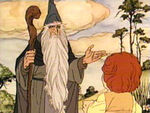 |
 |
 |
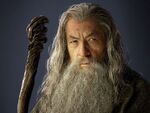 |
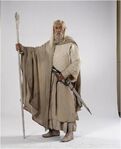 |
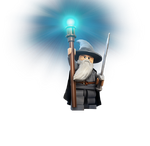 |
 |
 |
 |
 |
 |
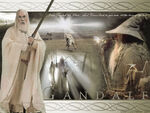 |
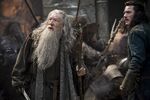 |
 |
 |
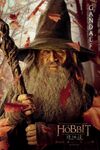 |
Translations around the World
| Foreign Language | Translated name |
|---|---|
| Amharic | ጛንዳልፍ |
| Arabic | غاندالف |
| Armenian | Գանդալֆ |
| Belarusian Cyrillic | Гэндальф |
| Bengali | গ্যানডালফ |
| Bulgarian Cyrillic | Гандалф |
| Catalan | Gàndalf |
| Chinese (Hong Kong) | 甘道夫 |
| Dari | عاندالف |
| Esperanto | Gandalfo |
| Georgian | განდალფი Gandalpi (Latin) |
| Greek | Γανδαλφ |
| Hebrew | גאנדאלף |
| Italian | Gandalf |
| Japanese | ガンダルフ |
| Kannada | ಗನ್ದಲ್ಫ಼್ |
| Kazakh Cyrillic | Гандалф |
| Korean | 간달프 |
| Kyrgyz Cyrillic | Гандалф |
| Latin | Gandalfus |
| Lithuanian | Gendalfas |
| Macedonian Cyrillic | Гандалф |
| Marathi | गन्दल्फ़ |
| Mongolian Cyrillic | Гандалф |
| Nepalese | ङन्दल्फ़् ? |
| Norwegian | Gandalv |
| Pashto | ګاندالف |
| Persian | گندالف |
| Punjabi | ਗਨ੍ਦਲ੍ਫ਼ |
| Russian | Гэндальф |
| Serbian | Гандалф (Cyrillic) Gandalf (Latinised) |
| Sinhalese | ගඳල්ෆ් |
| Tajik Cyrillic | Гандалф |
| Thai | แกนดัล์ฟ |
| Tigrinya | ጛንዳልፍ |
| Ukrainian Cyrillic | Ґандальф |
| Urdu | عاندالف ? |
| Uyghur | غاندالف |
| Uzbek | Гандалф (Cyrillic) Gandalf (Latin) |
| Yiddish | גאַנדאַלפֿ |
References
- ↑ Unfinished Tales, Part Four: II: "The Istari"
- ↑ 2.0 2.1 The Lord of the Rings, Appendix B: The Tale of Years (Chronology of the Westlands), "The Third Age"
- ↑ Unfinished Tales, Introduction, Part Four, II: "The Istari"
- ↑ The Hobbit, Chapter I: "An Unexpected Party"
- ↑ Unfinished Tales, Introduction, Part Three, III: "The Quest of Erebor"
- ↑ 6.0 6.1 The Hobbit, Chapter II: "Roast Mutton"
- ↑ The Hobbit, Chapter V: "Riddles in the Dark"
- ↑ The Hobbit, Chapter VIII: "Flies and Spiders"
- ↑ The Hobbit, Chapter XIX: "The Last Stage"
- ↑ The Lord of the Rings, The Fellowship of the Ring, Book One, Chapter I: "A Long-expected Party"
- ↑ The Lord of the Rings, The Fellowship of the Ring, Book One, Chapter II: "The Shadow of the Past"
- ↑ The Lord of the Rings, Appendix B: The Tale of Years (Chronology of the Westlands), "The Great Years"
- ↑ The Lord of the Rings, The Fellowship of the Ring, Book One, Chapter X: "Strider"
- ↑ The Lord of the Rings, The Fellowship of the Ring, Book One, Chapter XI: "A Knife in the Dark"
- ↑ The Lord of the Rings, The Fellowship of the Ring, Book One, Chapter XII: "Flight to the Ford"
- ↑ 16.0 16.1 The Lord of the Rings, The Fellowship of the Ring, Book Two, Chapter II: "The Council of Elrond"
- ↑ 17.0 17.1 The Lord of the Rings, The Fellowship of the Ring, Book Two, Chapter V: "The Bridge of Khazad-dûm"
- ↑ The Lord of the Rings, The Two Towers, Book Three, Chapter V: "The White Rider"
- ↑ 19.0 19.1 The Lord of the Rings, The Two Towers, Book Three, Chapter VI: "The King of the Golden Hall"
- ↑ The Lord of the Rings, The Two Towers, Book Three, Chapter VII: "Helm's Deep"
- ↑ The Lord of the Rings, The Return of the King, Book Five, Chapter IX: "The Last Debate"
- ↑ The Lord of the Rings, The Return of the King, Book Six, Chapter IV: "The Field of Cormallen"
- ↑ The Lord of the Rings, The Return of the King, Book Six, Chapter IX: "The Grey Havens"
- ↑ 24.0 24.1 The History of Middle-earth, Vol. 5: The Lost Road and Other Writings, Part Three: "The Etymologies"
- ↑ 25.0 25.1 25.2 The History of Middle-earth, Vol. 8: The War of the Ring, Part Two: The Ring Goes East, V: "Faramir"
- ↑ Parma Eldalamberon, Words, Phrases and Passages in Various Tongues in The Lord of the Rings by J.R.R. Tolkien
- ↑ The Letters of J. R. R. Tolkien, Letter 107
- ↑ Manfred Zimmerman, The Origin of Gandalf and Josef Madlener, Mythlore 34 (1983)
- ↑ http://www.vanityfair.com/hollywood/2016/12/david-bowie-gandalf-elrond-lotr
| Thorin and Company | |
|---|---|
| Thorin II • Balin • Dwalin • Fíli • Kíli • Dori • Nori • Ori • Óin • Glóin • Bifur • Bofur • Bombur • Gandalf • Bilbo Baggins | |
| The Fellowship of the Ring | ||||||||
|---|---|---|---|---|---|---|---|---|
| Frodo · Sam · Merry · Pippin · Gandalf · Aragorn · Legolas · Gimli · Boromir | ||||||||
| People: Faramir · Sauron · Witch-king of Angmar · Gollum · Elrond · Frodo Baggins · Samwise Gamgee · Meriadoc Brandybuck · Peregrin Took · Gandalf · Aragorn II · Legolas · Gimli · Boromir · Galadriel · Elves · Hobbits Locations: Middle-earth · Gondor · Mordor · Rohan Other: Mithril · Middle-earth Strategy Battle Game · The Fellowship of the Ring: Being the First Part of The Lord of the Rings · Works inspired by J. R. R. Tolkien · The Lord of the Rings · The Lord of the Rings (1978 film) · Ainulindalë · Tolkien vs. Jackson · Tengwar · Quenya |










